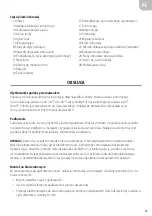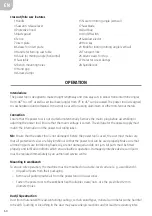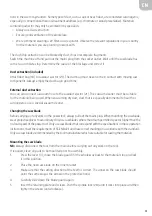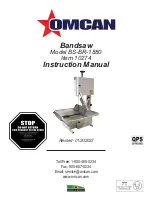
EN
44
• Only guide the saw blade towards the workpiece when the machine is switched on. Otherwise,
there is risk of kickback if the saw blade becomes wedged in the workpiece.
• Keep the handles dry, clean and free of oil and grease. Greasy and oily handles are slippery and
may cause you to lose control.
• Operate the power tool only when the work area is clear of adjusting tools, wood chips, etc.
Only the workpiece must be in this area. Small pieces of wood or other objects that come in
contact with the rotating saw blade may strike the operator at high speed.
• Keep the floor clear of wood chips and material remainders, as these may cause you to slip or
stumble.
• Always firmly clamp the workpiece. It is safer to secure it with a clamp than to hold it with your
hand. Do not saw a workpiece that is not secured in place - the clearance of your hand in relation
to the rotating saw blade is too small if it slips.
• Only use power tools suitable for the intended material - overheating may occur otherwise.
• If the saw blade should become jammed, switch the machine off and hold the workpiece in place
until the saw blade comes to a complete stop. To prevent kickback, do not remove the workpiece
until the saw blade has come to a complete stop. Correct the cause of the saw blade jamming
before restarting the machine.
• Never use dull, cracked, bent or damaged saw blades. Unsharpened or improperly set saw blades
produce narrow kerf. This causes excessive friction, blade binding and the risk of kickback.
• Always use the correct size blades and arbor holes (e.g. star-shaped or round). Saw blades that do
not match the mounting hardware of the saw will soon run eccentrically, causing loss of control.
Never use HSS (high speed steel) saw blades. This type of blade breaks easily.
• After working, do not touch the saw blade until it has cooled. The saw blade gets very hot while
you are working.
• Never operate the tool without the insert plate. Replace defective insert plates. If there is a fault
with the insert plate, the blade may injure you.
• Check the power cord regularly. If it is damaged, it should be replaced by an authorised service
representative. If the extension cord is damaged, it should be replaced. This will ensure that safety
is maintained.
• Always store the power tool safely. The storage location must be dry and lockable to protect the
machine from damage in storage and prevent it from being operated by untrained persons.
• Never leave the machine unattended before it has come to a complete stop. Cutting tools that are
still running may cause injury.
• Never use a power tool when the cable is damaged. If the cable is damaged while working,
do not touch it and pull out the plug. Damaged cords will increase the risk of electric shock.
Summary of Contents for 242130
Page 9: ...SE 9 BESKRIVNING ...
Page 10: ...SE 10 ...
Page 11: ...SE 11 ...
Page 22: ...NO 22 BESKRIVELSE ...
Page 23: ...NO 23 ...
Page 24: ...NO 24 ...
Page 34: ...PL 34 OPIS ...
Page 35: ...PL 35 ...
Page 36: ...PL 36 ...
Page 47: ...EN 47 DESCRIPTION ...
Page 48: ...EN 48 ...
Page 49: ...EN 49 ...










































